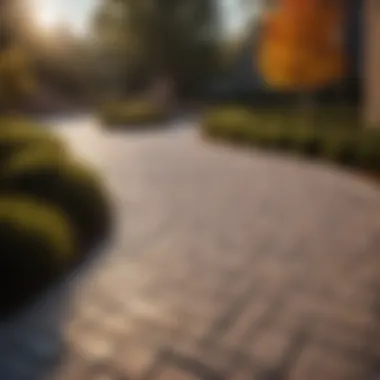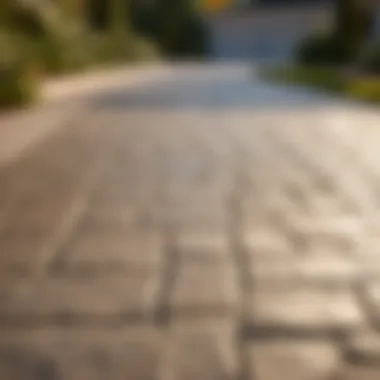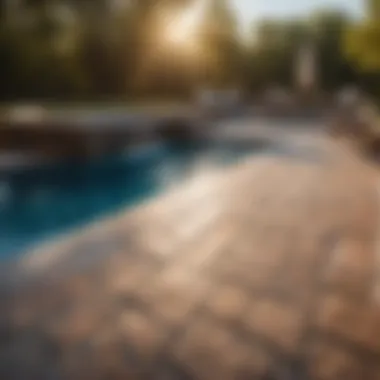Materials:
-
Stamped Concrete:
- Concrete mix: 10 bags of 80lb concrete mix
- Stamps: assortment of stamp patterns for design
- Color hardener: 3 buckets for coloring
- Release agent: 2 gallons for stamp release
- Sealant: 5 gallons for finishing touch
-
Pavers:
- Pavers: 500 square feet of concrete pavers
- Sand: 1 cubic yard of paver sand
- Edging: 100 linear feet of paver restraint
- Vibratory plate compactor: for compacting the base
- Leveling tool: to ensure pavers are even
DIY Steps:
Stamped Concrete:
- Prepare the area by clearing debris and compacting the soil.
- Mix concrete according to instructions, adding color hardener for desired shade.
- Pour and level the concrete before applying stamps in desired patterns.
- Release stamps carefully to avoid smudging, allowing the concrete to set.
- Seal the surface for protection and added shine.
Pavers:
- Excavate the area to a depth allowing for base, sand, and paver thickness.
- Lay down geotextile fabric as a weed barrier before adding paver base and compacting with a plate compactor.
- Lay pavers in desired pattern, ensuring proper alignment and spacing.
- Secure the outer edge with restraint and fill joints with sand for stability.
- Compact the entire surface once more to set pavers firmly.
Technical Aspects:
- Proper timing is crucial to avoid concrete drying too quickly or pavers shifting during installation.
- Using the correct stamp pattern and color combination enhances the overall aesthetic appeal.
- Precision in leveling and alignment is key to a professional-looking finish.
- Regular maintenance such as resealing stamped concrete or repairing loose pavers ensures longevity.
DIY Project Process:


- Carefully measure and plan before starting to ensure project materials are sufficient.
- Follow steps with precision to avoid costly mistakes or rework.
- Troubleshoot by adjusting alignment or adding more sand to stabilize pavers if needed.
- Enjoy the final result by admiring the newly transformed space, whether it's a stamped concrete patio or a paver walkway.
Introduction


Stamped concrete and pavers are popular choices for construction projects, each offering distinct advantages and disadvantages. Understanding the differences between these materials is crucial for homeowners and contractors seeking to make informed decisions about their landscaping and outdoor design projects. This article delves into the comparison of stamped concrete versus pavers, analyzing key factors such as durability, cost, maintenance, and aesthetic appeal to guide readers in selecting the most suitable material for their specific needs.
Definition of Stamped Concrete and Pavers
Stamped concrete is a cost-effective alternative to traditional paving methods that involves imprinting patterns or textures onto freshly poured concrete to mimic the look of bricks, stones, or tiles. On the other hand, pavers are individual units made from various materials such as concrete, clay, or natural stone, which are laid on a prepared base to create a durable and visually appealing surface. Both stamped concrete and pavers offer unique aesthetic possibilities and functional benefits, making them popular choices for enhancing outdoor spaces.
Importance of Material Selection
Choosing between stamped concrete and pavers is a crucial decision that can significantly impact the outcome of a construction project. The material selected not only influences the overall look and feel of the space but also affects factors such as durability, maintenance requirements, and cost considerations. By carefully evaluating the advantages and disadvantages of stamped concrete and pavers in relation to the specific project requirements, individuals can ensure they make an informed choice that aligns with their desired outcomes and long-term objectives.
Pros and Cons of Stamped Concrete


In this section, we delve into the detailed analysis of the pros and cons of using stamped concrete for construction projects. Stamped concrete is a popular choice due to its versatility and aesthetic appeal, but like any material, it comes with its set of advantages and disadvantages that need thorough consideration. Understanding the benefits and drawbacks of stamped concrete is crucial for making informed decisions when planning your construction project.
Pros
Durable and Long-Lasting
Stamped concrete is renowned for its exceptional durability and long-lasting qualities. This material can withstand various weather conditions and heavy foot traffic without losing its structural integrity. The key characteristic of durability in stamped concrete lies in its ability to resist wear and tear over time, making it a popular choice for outdoor spaces and high-traffic areas. The unique feature of stamped concrete's durability is its cost-effectiveness in the long run, as it requires minimal repairs and replacements compared to other materials.
Versatile Design Options
One of the significant advantages of using stamped concrete is its versatility in design options. Stamped concrete can mimic the look of various materials such as brick, stone, or wood, allowing for customized and creative designs. The key characteristic of versatile design options in stamped concrete is the ability to achieve intricate patterns and textures that enhance the visual appeal of the space. The unique feature of stamped concrete's design versatility is the cost savings it offers compared to using natural materials while still achieving the desired aesthetic.
Low Maintenance
Stamped concrete is relatively low maintenance compared to other paving materials. Routine cleaning and sealing are generally all that is needed to keep stamped concrete looking fresh and vibrant. The key characteristic of low maintenance in stamped concrete is the minimal effort required to upkeep its appearance, making it a practical choice for homeowners seeking a hassle-free option. The unique feature of stamped concrete's low maintenance is its ability to retain its like-new appearance with simple care practices, saving time and money on extensive maintenance routines.
Cons
Potential for Cracks
Despite its durability, stamped concrete is prone to developing cracks over time, especially if not properly installed or maintained. The key characteristic of the potential for cracks lies in the nature of concrete as a material that may experience expansion and contraction with temperature changes, leading to surface imperfections. The unique feature of stamped concrete's potential for cracks is the need for proactive measures such as proper installation techniques and regular inspections to prevent and address any cracking issues promptly.
Installation Costs
The initial installation costs of stamped concrete can be higher than some alternative paving materials. Factors such as labor, materials, and customization options can contribute to the overall cost of using stamped concrete for a project. The key characteristic of installation costs in stamped concrete highlights the importance of budget planning and weighing the long-term benefits against the upfront expenses. The unique feature of stamped concrete's installation costs is the potential for cost savings in maintenance and replacement over the lifespan of the material.
Resealing Requirements
Stamped concrete typically requires regular resealing to maintain its appearance and durability. The frequency of resealing depends on factors such as exposure to sun, moisture, and heavy use. The key characteristic of resealing requirements in stamped concrete is the need for consistent upkeep to preserve the material's quality and enhance its longevity. The unique feature of stamped concrete's resealing requirements is the opportunity to refresh the surface periodically, extending the lifespan and visual appeal of the installation over time.
Pros and Cons of Pavers
In this section, we delve into the crucial aspects of the pros and cons of choosing pavers for your construction projects. Understanding the benefits and drawbacks of utilizing pavers is fundamental in making informed decisions regarding your outdoor spaces. Pavers offer a range of positive attributes, such as ease of repair, aesthetic appeal, and permeable options for drainage, but they also come with challenges like weed growth between pavers, higher initial costs, and the need for regular maintenance.
Pros
Ease of Repair
Ease of repair is a standout feature when it comes to pavers. The ability to individually replace or adjust pavers makes maintenance simple and cost-effective. This characteristic ensures that even if a single paver gets damaged, it can be swiftly swapped out without the need to redo the entire surface. The ease of repair contributes significantly to the longevity of a paved area, offering practicality and convenience to homeowners or contractors.
Aesthetic Appeal
The aesthetic appeal of pavers is a key driver for their popularity. Pavers come in a variety of colors, shapes, and patterns, allowing for creative and customizable designs. Whether creating intricate layouts or simple arrangements, pavers enhance the visual appeal of outdoor spaces. The uniformity and precision of pavers add a touch of elegance and sophistication to driveways, pathways, patios, or any other paved area.
Permeable Options for Drainage
Permeable options for drainage are a strategic advantage of pavers. The design of permeable pavers allows water to infiltrate the surface and percolate into the ground, reducing runoff and aiding in groundwater recharge. This eco-friendly feature is beneficial in preventing water accumulation, minimizing erosion, and maintaining the natural hydrological balance of the environment.
Comparison Factors
In this detailed comparison of stamped concrete versus pavers, the focus shifts to examining key factors that play a crucial role in determining which material is best suited for construction projects. Durability, cost considerations, maintenance requirements, and aesthetic appeal are the pivotal aspects that housewives and homeowners need to consider when making a decision between stamped concrete and pavers. Understanding these comparison factors not only helps in enhancing the visual appeal of the property but also ensures long-term structural integrity and cost-efficiency.
Durability
Durability is a critical factor to consider when choosing between stamped concrete and pavers for construction projects. Stamped concrete is known for its exceptional strength and resilience, offering a long-lasting surface that can withstand various weather conditions and heavy foot traffic. On the other hand, pavers are praised for their durability and flexibility, especially in areas where ground shifting is common. By evaluating the durability aspect, homeowners can make informed decisions based on the specific requirements of their project, ensuring longevity and performance.
Cost Considerations
When assessing the cost considerations of stamped concrete versus pavers, several factors come into play. Stamped concrete is generally more cost-effective in terms of upfront installation costs compared to pavers. However, it is essential to consider long-term expenses such as maintenance and potential repairs. Pavers may have higher initial costs, but their versatility in design, ease of repair, and long-term cost savings make them a valuable investment for homeowners seeking durable and aesthetically pleasing outdoor surfaces.
Maintenance Requirements
Understanding the maintenance requirements of stamped concrete and pavers is crucial for preserving the visual appeal and structural integrity of the surfaces. Stamped concrete requires regular sealing to protect against stains, moisture penetration, and wear. Conversely, pavers may require periodic re-sanding and resealing to prevent weed growth and maintain stability. By factoring in maintenance needs, homeowners can choose the material that aligns with their maintenance preferences and budget constraints.
Aesthetic Appeal
Aesthetic appeal plays a significant role in the decision-making process between stamped concrete and pavers. Stamped concrete offers a wide range of design options, including patterns that mimic natural stone, brick, or tile, providing homeowners with versatile choices to enhance their outdoor spaces. On the other hand, pavers add a touch of elegance and sophistication with their interlocking patterns and texture variations, creating visually appealing pathways, patios, and driveways. Evaluating the aesthetic appeal of both materials allows homeowners to envision the desired look and feel of their outdoor living areas, ensuring a cohesive design that complements the overall landscape and architecture.
Conclusion
In this in-depth analysis of the comparison between stamped concrete and pavers, we have uncovered essential factors for consideration when deciding between these materials for construction projects. The conclusion drawn from this exploration is pivotal in guiding individuals towards making informed choices that align with their specific requirements and preferences. By evaluating aspects such as durability, cost, maintenance, and aesthetics, readers can effectively determine the most suitable material for their project, ensuring long-term satisfaction and functionality.
Best Applications for Stamped Concrete
When considering the best applications for stamped concrete, this material proves to be highly advantageous for outdoor spaces such as patios, driveways, and walkways where a decorative flair is desired. Stamped concrete offers versatility in design options, allowing for the replication of natural materials like stone or brick at a more affordable cost. Its durability and longevity make it a practical choice for areas with high foot traffic, while the low maintenance requirements ensure ease of upkeep, making it an optimal choice for busy homeowners seeking both aesthetic appeal and functionality in their outdoor spaces.
Best Applications for Pavers
Pavers excel in applications where versatility and easy repair are essential, making them ideal for areas like driveways, pathways, and courtyards. The aesthetic appeal of pavers adds charm and character to outdoor spaces, enhancing the overall ambiance of a property. Additionally, the permeable options for drainage make pavers a smart choice for environments where water runoff management is crucial. While initial costs may be higher than other materials, the long-term benefits of pavers in terms of durability and design flexibility outweigh the initial investment, making them a favored choice for homeowners seeking a timeless and customizable outdoor look.
Final Considerations
As you navigate through the decision-making process between stamped concrete and pavers, it is essential to weigh the pros and cons carefully against your specific project requirements and long-term goals. Consider factors such as budget, design preferences, maintenance capacity, and intended use when selecting the most suitable material for your construction project. By taking the time to evaluate all aspects thoroughly, you can ensure a successful outcome that not only meets your immediate needs but also adds long-lasting value and aesthetic appeal to your property. Make an informed choice based on a comprehensive understanding of both stamped concrete and pavers to create a space that reflects your unique style and functional needs.





